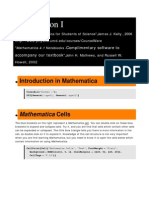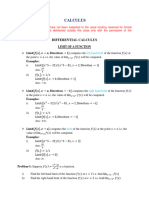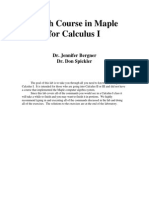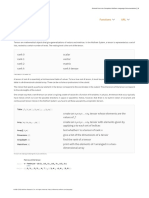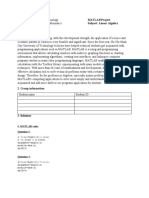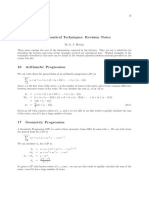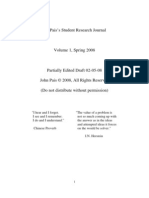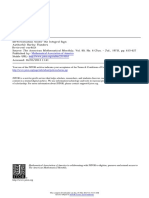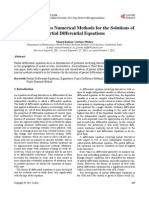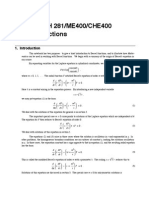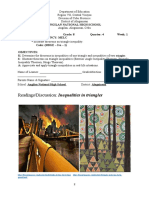THE UNIVERSITY OF HONG KONG
DEPARTMENT OF MATHEMATICS
MATH1013 University Mathematics II
Tutorial 9 Solutions
1. Let u = sin x. Then du = cos x dx. This gives
cos x 1 1
∫ sec x dx = ∫ 2
dx = ∫ 2
(cos x dx) = ∫ du.
cos x 1 − sin x 1 − u2
As 1 − u2 = (1 − u)(1 + u), we can write
1 A B
2
= +
1−u 1−u 1+u
for some constants A and B. This implies 1 = A(1 + u) + B(1 − u). Putting u = 1, we obtain
1 1
A = . Putting u = −1, we obtain B = . It follows that
2 2
1 1 1
∫ sec x dx = ∫ ( + ) du
2 1−u 1+u
1
= (− ln ∣1 − u∣ + ln ∣1 + u∣) + C
2
1 1 + sin x
= ln + C.
2 1 − sin x
x 1 + tan x2
Remark. If one uses the substitution t = tan , one obtains the answer ln ∣ ∣ + C.
2 1 − tan x2
One can verify that this is the same as the above answer.
2. Note that x = −2 is a root of x3 + 2x2 + x + 2 = 0. This gives x3 + 2x2 + x + 2 = (x + 2)(x2 + 1).
Therefore, we can write
2x2 + 2x + 1 A Bx + C
= + 2
x3 + 2x2 + x + 2 x + 2 x +1
for some constants A, B and C. This implies
2x2 + 2x + 1 = A(x2 + 1) + (Bx + C)(x + 2).
Putting x = −2, we obtain A = 1. The equation becomes x2 + 2x = (Bx + C)(x + 2), i.e.
x = Bx + C. This gives (B, C) = (1, 0). Thus,
3 2x2 + 2x + 1 3 1 x
∫ 3 2
dx = ∫ ( + 2 ) dx
1 x + 2x + x + 2 1 x+2 x +1
3 1 3 1
=∫ dx + ∫ d(x2 + 1)
1 x+2 1 2(x2 + 1)
x=3
1
= [ln (x + 2) + ln (x2 + 1)]
2 x=1
1 1
= ln 5 + ln 10 − ln 3 − ln 2
√2 2
5 5
= ln .
3
1
� x π 1
3. We use the substitution t = tan . When x = 0, t = 0. When x = , t = √ . Therefore, we
2 3 3
have π 1 1
2
3 x √
3 1+t 2 √
3 2t
∫ sec x tan dx = ∫ 2
⋅t⋅ 2
dt = ∫ dt.
0 2 0 1−t 1+t 0 1 − t2
Since 1 − t2 = (1 − t)(1 + t), there exist constants A and B such that
2t A B
= + .
1 − t2 1 − t 1 + t
This means
2t = A(1 + t) + B(1 − t).
Putting t = 1, we get A = 1. Putting t = −1, we get B = −1. Thus,
1 1 1
√
3 2t √
3 1 1 t= √
3
∫ 2
dt = ∫ ( − ) dt = [− ln (1 − t) − ln (1 + t)]
0 1−t 0 1−t 1+t t=0
t= √1 3
= [− ln (1 − t2 )]
3
= ln .
t=0 2
4. The argument is incorrect because the area below the x-axis and the area above the x-axis
are both ∞. We cannot consider any cancellation between the infinity areas. Indeed, by
definition, we have
∞ t x=t
∫ sin x dx = lim ∫ sin x dx = lim [− cos x] = lim (1 − cos t),
0 t→∞ 0 t→∞ x=0 t→∞
which does not exist as cos t oscillates between −1 and 1. So the integral diverges.
5. If a < b < 0, then
b 1 x=b b
∫ dx = [ln (−x)] = ln (−b) − ln (−a) = ln .
a x x=a a
If 0 < a < b, then
b 1 x=b b
∫ dx = [ln x] = ln b − ln a = ln .
a x x=a a
If b = 0, then
1 t 10 t
dx = lim− ∫
∫ dx = lim− ln = −∞.
a x t→0 a x t→0 a
The integral diverges. As a corollary, the integral diverges if a < 0 < b.
If a = 0, then
b 1 b 1 b
∫ dx = lim+ ∫ dx = lim+ ln = ∞.
0 x t→0 t x t→0 t
The limit diverges.
6. (a) Define f (t) = sin t. For every x ∈ (0, 1], by Taylor’s theorem, there exists ξ ∈ (0, x) such
that
f ′′ (ξ)
f (x) = f (0) + f ′ (0)(x − 0) + (x − 0)2 .
2
2
� As f ′ (t) = cos t and f ′′ (t) = − sin t, this means
sin ξ 2
sin x = x − x .
2
Note that
x
sin x >
2
sin ξ 2 x
⇔ x− x >
2 2
x sin ξ 2
⇔ > x
2 2
⇔ 1 > x sin ξ.
This is true since 0 < x ⩽ 1 and 0 < sin ξ < sin x ⩽ sin 1 < 1.
x
Remark. A simpler method is to show that g(x) = sin x − is strictly increasing on
2
[0, 1], and hence g(x) > g(0) = 0 for x ∈ (0, 1]. We provide an alternative method above
to show a different usage of Taylor’s theorem other than approximation.
1 1 1
(b) For any x ⩾ 1, we have ∈ (0, 1]. By part (a), we have sin > > 0. As
x x 2x
∞ 1 t 1 1 x=t
1
∫ dx = lim ∫ dx = lim [ ln x] = lim ln t = ∞,
1 2x t→∞ 1 2x t→∞ 2 x=1 t→∞ 2
∞ 1
the integral ∫ sin dx also diverges to ∞ by the comparison test.
1 x
Additional problems:
7. (a) Note that 2x2 + 5x − 12 = (x + 4)(2x − 3). Thus, we can write
−4x + 17 A B
2
= +
2x + 5x − 12 x + 4 2x − 3
for some constants A and B. This implies −4x + 17 = A(2x − 3) + B(x + 4). Putting x = −4,
3
we obtain A = −3. Putting x = , we obtain B = 2. It follows that
2
1 −4x + 17 1 −3 2
∫ dx = ∫ ( + ) dx
−1 2x2 + 5x − 12 −1 x + 4 2x − 3
x=1
= [−3 ln (x + 4) + ln (3 − 2x)]
x=−1
= −4 ln 5 + 3 ln 3.
(b) Note that x3 − 7x2 + 8x + 16 = (x − 4)2 (x + 1). Thus, we can write
2x2 − 19x + 54 A B C
3 2
= + 2
+
x − 7x + 8x + 16 x − 4 (x − 4) x+1
for some constants A, B and C. This implies
2x2 − 19x + 54 = A(x − 4)(x + 1) + B(x + 1) + C(x − 4)2 .
3
� Putting x = 4, we obtain B = 2. Putting x = −1, we obtain C = 3. Putting x = 0, we obtain
54 = −4A + B + 16C, and hence A = −1. It follows that
−2 2x2 − 19x + 54 −2 −1 2 3
∫ dx = ∫ ( + + ) dx
−3 3 2
x − 7x + 8x + 16 −3 x − 4 (x − 4) 2 x+1
x=−2
2
= [− ln (4 − x) − + 3 ln (−x − 1)]
x−4 x=−3
1 2
= − ln 6 + + ln 7 − − 3 ln 2
3 7
7 1
= ln + .
48 21
(c) Note that (x − 1)(x − 2)(x + 3)2 = x4 + 3x3 − 7x2 − 15x + 18. By long division, we find that
2x5 + 5x4 − 14x3 − 4x2 + 57x − 30 3x3 + 19x2 + 6x − 12
= 2x − 1 + .
(x − 1)(x − 2)(x + 3)2 (x − 1)(x − 2)(x + 3)2
Next, we write
3x3 + 19x2 + 6x − 12 A B C D
= + + +
(x − 1)(x − 2)(x + 3)2 x − 1 x − 2 x + 3 (x + 3)2
for some constants A, B, C and D. This implies
3x3 + 19x2 + 6x − 12 = A(x − 2)(x + 3)2 + B(x − 1)(x + 3)2 + [C(x + 3) + D](x − 1)(x − 2).
Putting x = 1, we obtain A = −1. Putting x = 2, we obtain B = 4. Putting x = −3, we
obtain D = 3. Putting x = 0, we obtain −12 = −18A − 9B + 6C + 2D, and hence C = 0. It
follows that
2x5 + 5x4 − 14x3 − 4x2 + 57x − 30 −1 4 3
∫ 2
dx = ∫ (2x − 1 + + + ) dx
(x − 1)(x − 2)(x + 3) x − 1 x − 2 (x + 3)2
3
= x2 − x − ln ∣x − 1∣ + 4 ln ∣x − 2∣ − + C ′.
x+3
8. (a) Firstly, by proposition 1.5(k), we have
cos 2x + 1 2
cos4 x = ( )
2
1
= (cos2 2x + 2 cos 2x + 1)
4
1 cos 4x + 1
= ( + 2 cos 2x + 1)
4 2
1 1 3
= cos 4x + cos 2x + .
8 2 8
Using the product-to-sum formula (Q12(b) of tutorial 1), we have
1
cos 4x cos 3x = (cos 7x + cos x),
2
1 1
cos 2x cos 3x = (cos 5x + cos (−x)) = (cos 5x + cos x).
2 2
4
� Therefore, we have
4 1 1 3
∫ (cos x)(cos 3x) dx = ∫ ( (cos 7x + cos x) + (cos 5x + cos x) + cos 3x) dx
16 4 8
1 1 1 5
= sin 7x + sin 5x + sin 3x + sin x + C.
112 20 8 16
(b) Let u = sin x. Then du = cos x dx. Therefore,
sin3 x
π 1 1
4
√
2 u3 √
2 u3
∫π dx = ∫ du = ∫ du.
6 (cos x)(1 + sin2 x) 1
2
(cos2 x)(1 + u2 ) 1
2
(1 − u2 )(1 + u2 )
Note that (1 − u2 )(1 + u2 ) = (1 − u)(1 + u)(1 + u2 ). Thus, we can write
u3 A B Cu + D
= + +
(1 − u2 )(1 + u2 ) 1−u 1+u 1 + u2
for some constants A, B, C and D. This implies
u3 = A(1 + u)(1 + u2 ) + B(1 − u)(1 + u2 ) + (Cu + D)(1 − u)(1 + u).
1 1
Putting u = 1, we obtain A = . Putting u = −1, we obtain B = − . The equation becomes
4 4
1 1
u3 = (1 + u)(1 + u2 ) − (1 − u)(1 + u2 ) + (Cu + D)(1 − u)(1 + u),
4 4
i.e.
1
u(u2 − 1) = (Cu + D)(1 − u)(1 + u).
2
1 1
This implies − u = Cu + D, and hence C = − and D = 0. It follows that
2 2
sin3 x
π 1
4
√
2 1 1 u
∫π 2
dx = ∫ 1 ( − − ) du
6 (cos x)(1 + sin x) 2
4(1 − u) 4(1 + u) 2(1 + u2 )
1
u= √
1 1 1 2
= [− ln (1 − u) − ln (1 + u) − ln (1 + u2 )]
4 4 4 1
u= 2
1
u= √
1 2
= [− ln (1 − u4 )]
4 1
u= 2
1 5
= ln .
4 4
x
(c) Let t = tan . Then we have
2
1 1 2
∫ dx = ∫ ( dt)
1 + sin x − cos x 2t 1 − t2 1 + t2
1+ −
1 + t2 1 + t2
1
=∫ dt
t(t + 1)
1 1
=∫ ( − ) dt
t t+1
= ln ∣t∣ − ln ∣t + 1∣ + C
x x
= ln ∣tan ∣ − ln ∣tan + 1∣ + C.
2 2
5
� x
Remark. Although the substitution t = tan always works when computing the integral of
2
some rational functions of the trigonometric functions, we need not always use this method
if other methods may work. Therefore, in part (a) and part (b), we provide some alternative
solutions. Using trigonometric identities is sometimes necessary. For example, in part (a), one
x
needs to convert cos 3x to cos x using some identities if one uses the substitution t = tan .
2
x+1
2 tan θ (more accurately, θ = tan−1 √ ).
√
9. (a) Note that x2 + 2x + 3 = (x + 1)2 + 2. Let x + 1 =
√ 2
Then dx = 2 sec2 θ dθ. This implies
1 1 1 1 x+1
⋅ 2 sec2 θ dθ = √ θ + C = √ tan−1 √ + C.
√
∫ dx = ∫
x2 + 2x + 3 2
2 sec θ 2 2 2
By definition, we have
∞ 1 t 1
∫ dx = lim ∫ dx
0 x2 + 2x + 3 t→∞ 0 x2 + 2x + 3
1 t+1 1
= lim √ (tan−1 √ − tan−1 √ )
t→∞ 2 2 2
1 π 1
= √ ( − tan−1 √ ) .
2 2 2
The improper integral converges.
52
(b) Note that 3x2 + 11x − 4 = (3x − 1)(x + 4). As lim− (21 − 11x) = , lim (3x − 1)(x + 4) = 0
x→ 13 3 x→ 13 −
21 − 11x 1
and < 0 for x slightly smaller than , we have
3x2 + 11x − 4 3
21 − 11x
lim− = −∞,
x→ 13 3x2 + 11x − 4
1
1 3 21 − 11x
and so x = is a vertical asymptote. We first compute ∫ dx. We write
3 0 3x2 + 11x − 4
21 − 11x A B
= +
3x2 + 11x − 4 3x − 1 x + 4
for some constants A and B. This implies
21 − 11x = A(x + 4) + B(3x − 1).
1
Putting x = , we obtain A = 4. Putting x = −4, we obtain B = −5.
3
It follows that
t 21 − 11x t 4 5
∫ dx = ∫ ( − ) dx
0 3x2 + 11x − 4 0 3x − 1 x + 4
x=t
4
= [ ln (1 − 3x) − 5 ln (x + 4)]
3 x=0
4
= ln (1 − 3t) − 5 ln (t + 4) + 5 ln 4.
3
6
� As
t 21 − 11x 4
lim− ∫ dx = lim− ( ln (1 − 3t) − 5 ln (t + 4) + 5 ln 4) = −∞,
t→ 13 0 3x2 + 11x − 4 1
t→ 3 3
the improper integral diverges.
(c) By definition,
x+2 ∞
0 x+2 ∞ x+2
∣x∣
dx = ∫ ∣x∣
dx + ∫ dx.
e∣x∣
∫
−∞ e −∞ e 0
Firstly, using integration by parts, we have
0 x+2 0 x+2
dx = ∫ dx
∣x∣ e−x
∫
t e t
0
=∫ (x + 2) d(ex )
t
x=0 0
= [(x + 2)ex ] −∫ ex dx
x=t t
x=0
= 2 − (t + 2)et − [ex ]
x=t
= 1 − (t + 1)et .
This implies
x+2 0 0 x+2 t+1
dx lim dx = lim (1 − (t + 1)et ) = 1 − lim −t .
−∞ e∣x∣ e∣x∣
∫ = ∫
t→−∞ t t→−∞ t→−∞ e
∞
This is a limit of the form . By L’Hôpital’s rule, this is equal to
∞
1
1 − lim = 1.
t→−∞ −e−t
Similarly, we have
t x+2 t x+2
∫ ∣x∣
dx = ∫ dx
0 e 0 ex
t
= −∫ (x + 2) d(e−x )
0
x=t t
= [−(x + 2)e−x ] +∫ e−x dx
x=0 0
x=t
= −(t + 2)e−t + 2 − [e−x ]
x=0
= 3 − (t + 3)e−t .
This implies
∞ x+2 t x+2 t+3 1
dx lim dx = lim (3 − (t + 3)e−t ) = 3 − lim t = 3 − lim t = 3.
e∣x∣ e∣x∣
∫ = ∫
0 t→∞ 0 t→∞ t→∞ e t→∞ e
Combining these, we obtain
∞ x+2
dx = 1 + 3 = 4.
e∣x∣
∫
−∞
The improper integral converges.
7
� 1
10. No. Consider f (x) = √ defined on (0, 1]. Then
x
1 1 1 √ x=1 √
∫ f (x) dx = lim+ ∫ √ dx = lim+ (2 x) = lim+ (2 − 2 t) = 2.
0 t→0 t x t→0 x=t t→0
Remark. This shows an unbounded region may have a finite area.
11. For k = −1, we have
∞ 1 t 1 x=t
∫ dx = lim ∫ dx = lim [ln x] = lim ln t = ∞.
1 x t→∞ 1 x t→∞ x=1 t→∞
The integral diverges.
For k ≠ −1, we have
∞ t 1 k+1 x=t 1
∫ xk dx = lim ∫ xk dx = lim [ x ] = lim (tk+1 − 1).
1 t→∞ 1 t→∞ k+1 x=1 t→∞ k + 1
When k > −1, this is ∞. The integral diverges.
1
When k < −1, this is equal to − . The integral converges.
k+1
12. (a) For any x ⩾ 1, we have
4x − 2 4x 4x 4
0< < < = .
x7 + 3x2 + 1 x7 + 3x2 + 1 x7 x6
As ∞ ∞
4 4
dx = 4 ∫ x−6 dx =
∫
1 x6 1 5
∞ 4x − 2
by Q11, the improper integral ∫ dx also converges by the comparison test.
1 x + 3x2 + 1
7
1
(b) For any x ⩾ 2, we have x3 − 1 > x3 and 3x4 + 2x3 + 2 < 3x4 + 2x4 + 2x4 = 7x4 . Thus,
2
1 3
x3 − 1 2
x 1
> = > 0.
3x4 + 2x3 + 2 7x4 14x
Note that
∞ 1 1 ∞ 1 1 2 1 1 2 1
∫ dx = ∫ dx − ∫ dx = ∞ − ∫ dx = ∞
2 14x 14 1 x 14 1 x 14 1 x
by Q11 since the second integral is a definite integral (which is a finite real number).
∞ x3 − 1
Therefore, the improper integral ∫ dx also diverges by the comparison
2 3x + 2x3 + 2
4
test. It follows that
∞ x3 − 1 2 x3 − 1 ∞ x3 − 1
∫ dx = ∫ dx + ∫ dx
0 3x4 + 2x3 + 2 0 3x4 + 2x3 + 2 2 3x4 + 2x3 + 2
diverges as the first definite integral is finite.
8
� 1
(c) We first prove that ln x < x for all x ⩾ 1. Define f (x) = x − ln x. Then f ′ (x) = 1 − ⩾ 0.
x
This implies f is monotonic increasing, and hence f (x) ⩾ f (1) = 1 > 0. Therefore, ln x < x
for all x ⩾ 1. Thus,
ln x x
0 ⩽ x < x.
e e
Similar to a classwork question (subsection 5.3), we have
∞ x t x −x − 1 x=t 2 t+1
∫ x
dx = lim ∫ x
dx = lim [ x ] = lim ( − t ).
1 e t→∞ 1 e t→∞ e x=1 t→∞ e e
∞
The second term is an indeterminate form of type . Using L’Hôpital’s rule, this limit
∞
is equal to
2 1 2
− lim = .
e t→∞ et e
∞ x ∞ ln x
This shows ∫ dx converges. By the comparison test, ∫ dx also converges.
1 ex 1 ex
Remark. For improper integrals with unbounded domains involving rational functions, we
often compare the integrand with a power function xk and use the result of Q11 to apply the
comparison test.

